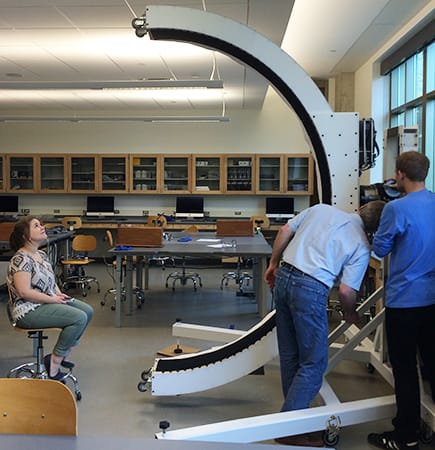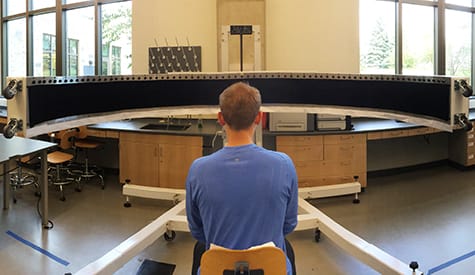St. Olaf News
Students build sophisticated device that tests sound localization
January 22, 2016
Mari Balhorn ’16, left, works with Physics Technician Devin Lackie (center) and Jake Westerberg ’16 (right) to test the SoLoArc device they designed and built along with Assistant Professor of Psychology Jeremy Loebach and Roman Tyshynsky ’16.
One of the most sophisticated new research devices at St. Olaf College is able to assist with faculty research, student research, and class projects — and it all started with a meter stick taped to the wall and three students willing to go out of their comfort zone to create something groundbreaking.
The device, called the SoLoArc, tests sound localization in the vertical and horizontal planes. In other words, it is able to present sound systematically so that researchers can test how well subjects are able to discriminate the location of the sounds they are hearing.
The system has 37 individual speakers and 73 LED lights on a 12-foot arc that can present sound and light every five degrees, and then subjects point to where they think the sound is coming from.
The ambitious project all started when Roman Tyshynsky ’16, Mari Balhorn ’16, and Jake Westerberg ’16 approached St. Olaf Assistant Professor of Psychology Jeremy Loebach about continuing a small research project that took place in the span of a three-hour lab in their Cellular and Molecular Neuroscience class in which they taped a meter stick to the wall, blindfolded subjects, and had them localize the sound of a pen click.
Loebach agreed to work with the students as a series of independent research projects to create the apparatus, and the end result was a device worlds more sophisticated than a meter stick and a clicking pen.
According to Loebach, the SoLoArc will be used in classes such as Sensation and Perception, Psychology of Hearing, and Cellular and Molecular Neuroscience, as well as his own research and student research projects. For example, Loebach will use the device in his research studying how people with cochlear implants localize sound in situations where their implants do not communicate with one another, or when they have a cochlear implant in one side and a hearing aid or normal hearing in the other.
Jake Westerberg ’16 serves as the subject for a trial run of SoLoArc, which tests sound localization in the vertical and horizontal planes.
The team presented two posters on the device at the Society for Neuroscience conference in Chicago, and are writing two papers on the build process: one focusing on collaborative research and creative engagement of students in research, and another on the device itself.
“I’ve wanted to build something like this for a while — we do activities with it in class, so this is a great way to involve the students and get something out of it that’s much bigger than what I would do on my own,” Loebach says.
The students worked closely with Devin Lackie, a technician from the Physics Department, as well as Loebach to design and build the device in the metal shop in Regents Hall of Natural and Mathematical Sciences.
“Both Professor Loebach and Devin did not simply do the work for us, but guided us through the process, taking our input as equals and modifying the construction process accordingly or explaining why an idea may not work,” Tyshynsky says. “It has been by and far the best collaborative project of which I have been a part.”
Although the students initially expected to be done with this project in one semester, the design turned out to be a lot more complicated, and it took them a full year to complete.
“We put a lot of hours in over the year it took to build it, and watching it all come together was one of the most satisfying and exhilarating experiences of my college career,” Balhorn says.
According to Loebach, the students created a device that was much more usable for maybe a tenth of the cost to buy something pre-made.
“We can do more with the investment that the college made, and we can do a lot more with the money than we would have been able to do otherwise,” he says.
Everyone involved in the project expressed great pride in the finished product.
“The most rewarding aspect was creating something that will outlast us with respect to our time at St. Olaf,” Westerberg says. “Students five, 10, even 20 years down the road could use this device to further their education. It is satisfying knowing that we have left a sort of legacy.”

